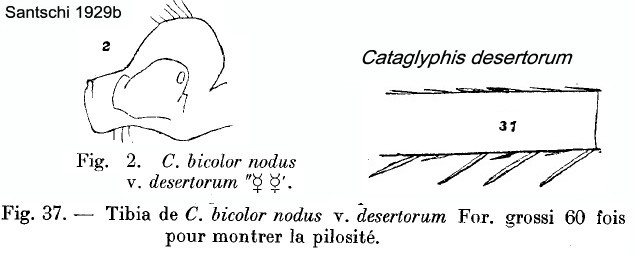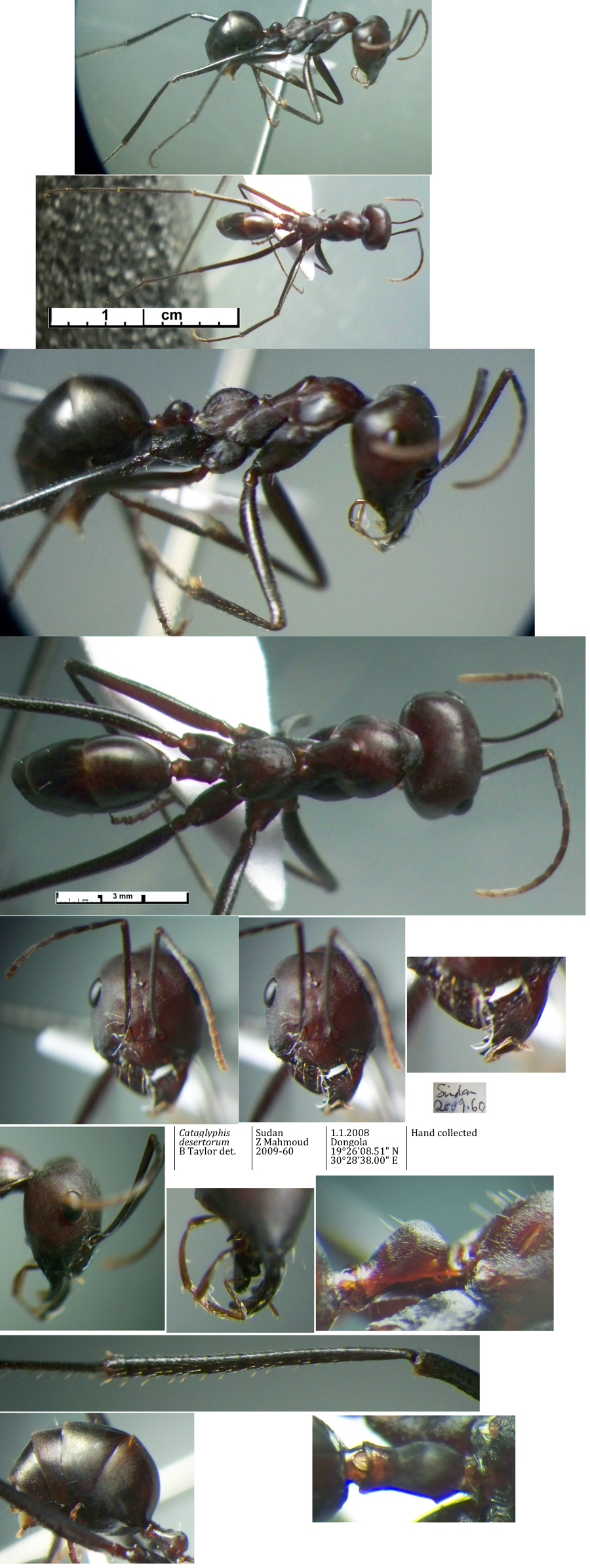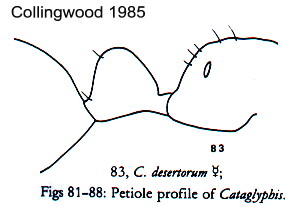Cataglyphis desertorum (Forel)
  Type location Ethiopia
(Myrmecocystus desertorum, Forel, 1894c: 402, worker; Karavaiev,
1912a: 17, male; raised to species Collingwood, 1985: 286. illustrated,
worker; revised status Agosti, 1990a: 1491), collector Ilg, from Harar
(type location wrongly given by Bolton, 1995: 135 as "Spain") - no
images on Antweb (January 2019) Type location Ethiopia
(Myrmecocystus desertorum, Forel, 1894c: 402, worker; Karavaiev,
1912a: 17, male; raised to species Collingwood, 1985: 286. illustrated,
worker; revised status Agosti, 1990a: 1491), collector Ilg, from Harar
(type location wrongly given by Bolton, 1995: 135 as "Spain") - no
images on Antweb (January 2019)  . .
|
 Forel's
(1894c) description of desertorum is at Forel's
(1894c) description of desertorum is at  . Emery (1898c) gave notes on desertorum,
these are at . Emery (1898c) gave notes on desertorum,
these are at  . The specimens he
examined appear to have been collected from Cairo, Egypt, by Professor
J Sahlberg. . The specimens he
examined appear to have been collected from Cairo, Egypt, by Professor
J Sahlberg.
As is surprisingly clear from Forel (1894c), the true
type location of desertorum was Ethiopia and neither
"Spain" nor "Tunisia". Santschi (1929b) gave the following, illustrated
description -  .
Forel noted it as having relatively short
legs and being very dark red in colour. Note: Cagniant (2009: 51)
opined that this is not a valid species, examples he had from Hassi
Messaoud, Algerian Sahara, matched the Forel types and, he felt, were Cataglyphis savignyi. .
Forel noted it as having relatively short
legs and being very dark red in colour. Note: Cagniant (2009: 51)
opined that this is not a valid species, examples he had from Hassi
Messaoud, Algerian Sahara, matched the Forel types and, he felt, were Cataglyphis savignyi.
|
The
photomontages below are of specimens from Tunisia and Sudan.
These specimens appear to be a good match for those
described and illustrated by Santschi (1929b) as desertorum;
with the domed petiole being very noticeable. The strong setae on the
hind tibiae with thick black pubescence (if that is what it is) are a
confusing feature not obvious from the poor descriptions of Forel,
Emery, or even Santschi.
|
 As noted above, there are
no images of the Forel type on Antweb (July 2014). This
photomontage of a worker identified by Santschi is collated from http://www.antweb.org/specimen.do?name=casent0249855. As noted above, there are
no images of the Forel type on Antweb (July 2014). This
photomontage of a worker identified by Santschi is collated from http://www.antweb.org/specimen.do?name=casent0249855.
A worker labelled savignyi but matching desertorum can be
seen at http://www.antweb.org/specimenImages.do?code=casent0280331
|
 Major
worker from Tunisia, Tozeur,
collector T Lackner; sent to me by
Peter Hlavac. Major
worker from Tunisia, Tozeur,
collector T Lackner; sent to me by
Peter Hlavac.
The location
is south of the main area of ecology studies by Wehner, Wehner &
Agosti (1994) but their distribution map (Fig. 11) has Cataglyphis
fortis in that area. Earlier, Wehner (1983) had commented that the
only Cataglyphis found in the salty plains is C. fortis.
|
 Minor worker from
Tunisia Minor worker from
Tunisia
|

The photomontage is of a worker from Sudan,
Dongola; 19°26'08.51" N 30°28'38.00" E; 1.1.2008; collector Zuheir
Mahmoud (Sudan 60).
|
 The status appears to have been confused by Collingwood
(1985: 286) who noted - "This is the dullest coloured of the reddish
species allied to C. bicolor (Fabricius). The head and alitrunk
are often brownish rather than red. The node is less massive than C.
niger (André) and has the anterodorsal face forming a flattened
curve rather than an evenly rounded dome". The status appears to have been confused by Collingwood
(1985: 286) who noted - "This is the dullest coloured of the reddish
species allied to C. bicolor (Fabricius). The head and alitrunk
are often brownish rather than red. The node is less massive than C.
niger (André) and has the anterodorsal face forming a flattened
curve rather than an evenly rounded dome".
Later, Collingwood & Agosti (1996: 383) wrote
"Cataglyphis sp.
Cataglyphis desertorum. - Collingwood 1985: Fauna
of Saudi Arabia 7: 286 [misidentification].
This is the commonest Cataglyphis species throughout Arabia and
there are many collections from the southern Sinai Peninsula to Saudi
Arabia, Kuwait, United Arab Emirates, Oman and Yemen. However, no nest
series is known, and only single workers were collected. in COLLINGWOOD
(1985), this species appeared under the name C. desertorum
Forel, 1894, but Forel's species, described from southern Tunisia, is
probably a synonym of C. savignyi (Agosti & Collingwood, in
prep.). For this reason, a formal description will be given later."
|
|